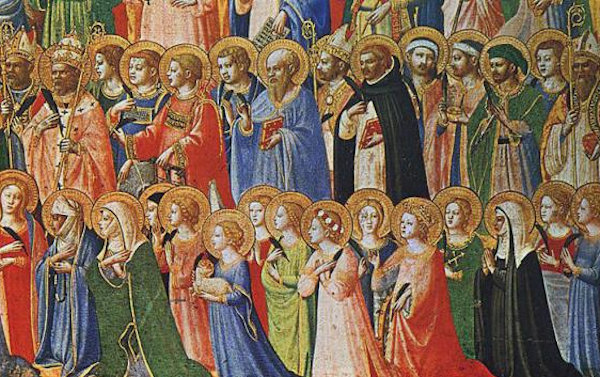John Wesley encouraged Methodists to remember and give thanks for saints gone to glory and those still living.
JOE IOVINO
United Methodist Communications
November 1 is All Saints Day, a sometimes-overlooked holy day in United Methodist congregations. It is not nearly as well known as the day before, All Hallows’ (Saints’) Eve, better known as Halloween, but is far more important in the life of the church.
John Wesley, founder of the Methodist movement, enjoyed and celebrated All Saints Day. In a journal entry from November 1, 1767, Wesley calls it “a festival I truly love.” On the same day in 1788, he writes, “I always find this a comfortable day.” The following year he calls it “a day that I peculiarly love.”
This may sound odd. United Methodists don’t believe in saints. Right?
Well, yes… and no.
Wesley cautioned against holding saints in too high regard. The Articles of Religion that he sent to the Methodists in America in 1784, include a statement against “invocation of saints” (Article XIV—Of Purgatory, Book of Discipline ¶104). Wesley did not see biblical evidence for the practice and discouraged Methodists from participating.
However, he also advised against disregarding the saints altogether.
In an All Saints Day journal entry dated Monday, November 1, 1756, Wesley writes, “How superstitious are they who scruple giving God solemn thanks for the lives and deaths of his saints!” If your 18th century English is as rusty as mine, it might help to know that the word scruple means, “to be unwilling to do something because you think it is improper, morally wrong, etc.” (Merriam-Webster.com).
Those to glory gone
All Saints Day is an opportunity to give thanks for all those who have gone before us in the faith. It is a time to celebrate our history, what United Methodists call the tradition of the church.
From the early days of Christianity, there is a sense that the Church consists of not only all living believers, but also all who have gone before us. For example, in Hebrews 12 the author encourages Christians to remember that a “great cloud of witnesses” surrounds us encouraging us, cheering us on.
Charles Wesley, John’s brother, picks up on this theme in his hymn that appears in our United Methodist Hymnal as “Come, Let Us Join our Friends Above,” #709. In the first verse, he offers a wonderful image of the Church through the ages:
Let saints on earth unite to sing, with those to glory gone,
for all the servants of our King in earth and heaven, are one.
On All Saints Day we remember all those—famous or obscure—who are part of the “communion of saints” we confess whenever we recite The Apostles’ Creed. We tell the stories of the saints “to glory gone.”
Alongside the likes of Paul from the New Testament, Augustine, Martin Luther, and John and Charles Wesley, we tell stories of the grandmother who took us to church every Sunday. We remember the pastor who prayed with us in the hospital, and the neighbor who changed the oil in the family car. We give thanks for the youth leader who told us Jesus loved us, the kindergarten Sunday school teacher who showered us with that love, and the woman in the church who bought us groceries when we were out of work.
Retelling these stories grounds us in our history. These memories teach us how God has provided for us through the generosity and sacrifice of those who have come before us. The stories of the saints encourage us to be all God has created us to be.
Saints on earth
Charles Wesley’s hymn tells us those “to glory gone” are joined by the “saints on earth,” whom we also celebrate on All Saints Day. We think of the inspirational people with whom we worship on Sunday, and those across the world we will never meet. We celebrate fellow United Methodists who inspire us, and those of other denominations whose lives encourage us. We give thanks for those with whom we agree, as well as those whose views we do not share.
Additionally, we remember and pray for our sisters and brothers in Christ who faithfully follow Jesus in places where being labeled a Christian puts them in harm’s way.
One song
On All Saints Day, we recognize that we are part of a giant choir singing the same song. It is the song Jesus taught his disciples; a tune that has resonated for more than 2,000 years; a melody sung in glory and on the earth. Our great privilege is to add our voices to this chorus.
The last verse of “Come, Let Us Join our Friends Above” encourages us to sing faithfully while on earth, so we might join the heavenly chorus one day.
Our spirits too shall quickly join, like theirs with glory crowned,
and shout to see our Captain’s sign, to hear His trumpet sound.
O that we now might grasp our Guide! O that the word were given!
Come, Lord of Hosts, the waves divide, and land us all in heaven.
On All Saints Day, let us give thanks for both the saints in glory and those on earth, who have led us to Jesus. As they have shared the gospel with us, may we add our voices so someone else may hear about the grace and love of our Lord and Savior Jesus Christ.
As we approach All Saints Sunday, November 6th, thanks be to God for the lives of his saints.
Last Updated on December 29, 2022

